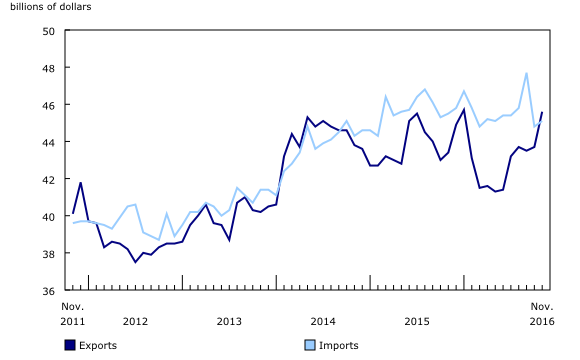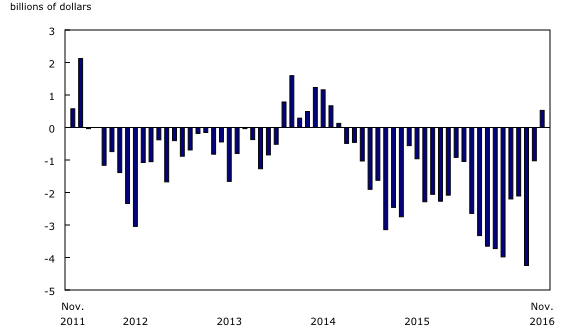Canadian international merchandise trade, November 2016
Archived Content
Information identified as archived is provided for reference, research or recordkeeping purposes. It is not subject to the Government of Canada Web Standards and has not been altered or updated since it was archived. Please "contact us" to request a format other than those available.
Released: 2017-01-06
Canada's merchandise trade balance with the world recorded its first trade surplus since September 2014, moving from a $1.0 billion deficit in October to a $526 million surplus in November. Exports were up 4.3%, on the strength of increased exports of metal and non-metallic mineral products as well as record exports to countries other than the United States. Imports were up 0.7%, mainly on higher imports of energy products.
Exports to countries other than the United States reach a record high
Exports to countries other than the United States rose 9.5% to a record $12.0 billion in November, surpassing the previous record set in December 2011. This was also the largest monthly percentage increase since May 2008. Exports to China were up 11.1% to $2.0 billion in November, mostly on higher exports of coal. Exports to South Korea, Brazil and Japan also increased in November.
Imports from countries other than the United States were up 3.5% to $15.6 billion in November. This increase was largely led by higher imports of crude oil from Norway, Algeria and Saudi Arabia. Lower imports from China partially offset these gains. Consequently, Canada's trade deficit with countries other than the United States narrowed from $4.2 billion in October to $3.7 billion in November, the smallest deficit since November 2014.
Exports to the United States also rose in November, up 2.5% to $33.7 billion, while imports from the United States were down 0.7% to $29.5 billion. Consequently, Canada's trade surplus with the United States widened from $3.2 billion in October to $4.2 billion in November, the largest surplus since June 2015.
Widespread increases in exports
Exports increased 4.3% to $45.6 billion in November, the highest level since the record $45.7 billion in January 2016. Export volumes rose 3.5% and prices were up 0.8%. Overall, 10 of 11 sections increased, a first since May 2014. In November, exports excluding energy products were up 4.7%. Year over year, total exports increased 5.2%.
Exports of metal and non-metallic mineral products increased 10.6% to $5.3 billion in November, the highest value since December 2014. Exports of unwrought precious metals and precious metal alloys led the gain, up 24.3% to $1.9 billion on larger shipments to Hong Kong and Switzerland. For the section as a whole, volumes rose 6.2% and prices 4.1%.
Exports of metal ores and non-metallic minerals rose 26.4% to $1.7 billion in November, with widespread increases throughout the section. Exports of potash increased 38.3% to $431 million on higher volumes. Exports of iron ores and concentrates also contributed to the gain, up 43.0% to $396 million, as prices rose 25.7%. Overall, volumes increased 15.0% and prices were up 9.9%.
Farm, fishing and intermediate food products also contributed to the gain in November, up 8.0% to $2.8 billion, mainly on higher volumes. Exports of canola were up 37.5% to $480 million, mostly due to higher exports to Pakistan.
Exports of aircraft and other transportation equipment and parts also rose in November, up 7.7% to $2.0 billion. After declining 33.4% in October, exports of aircraft increased 76.2% to $820 million. This gain was moderated by lower exports of boats and other personal transportation equipment, after increasing by $162 million in October on higher exports to Saudi Arabia.
Energy products lead the increase in imports
Total imports were up 0.7% to $45.1 billion in November, with 7 of 11 sections recording gains. Prices increased 1.0%, while volumes were down 0.3%. Higher imports of energy products and consumer goods were mostly offset by lower imports of aircraft and other transportation equipment and parts, and motor vehicles and parts. Year over year, total imports declined 0.8%.
After three consecutive monthly decreases, imports of energy products increased 18.2% to $2.4 billion in November. Imports of crude oil and crude bitumen were up 62.3% to $1.3 billion. This gain was moderated by lower imports of refined petroleum energy products, down 12.5% to $747 million in November. The increase in imports of crude oil and the decline in refined petroleum energy products coincided with increased refining activity in Eastern Canadian refineries in November, following scheduled maintenance in October. For the section as a whole, volumes rose 12.9% and prices were up 4.7%.
The increase was partially offset by lower imports of aircraft and other transportation equipment and parts, down 17.2% to $1.2 billion in November, the lowest level since July 2013. There were lower imports of aircraft, down $157 million to $48 million, mostly on fewer imports from the United States.
Increase in real exports
In real (or volume) terms, exports were up 3.5% in November as a result of widespread increases among the sections. Import volumes decreased 0.3%, led by lower real imports of motor vehicles and parts. Consequently, Canada's trade surplus with the world in real terms widened from $1.3 billion in October to $2.8 billion in November.
Revisions to October imports and exports
Revisions reflected initial estimates being updated with or replaced by administrative and survey data as they became available, and amendments made for late documentation of high-value transactions. Imports in October, originally reported as $44.7 billion in last month's release, were revised to $44.8 billion with the current month's release. Exports, originally reported as $43.6 billion in last month's release, were revised to $43.7 billion.
Note to readers
Merchandise trade is one component of Canada's international balance of payments (BOP), which also includes trade in services, investment income, current transfers and capital and financial flows.
International trade data by commodity are available on both a BOP and a customs basis. International trade data by country are available on a customs basis for all countries and on a BOP basis for Canada's 27 principal trading partners (PTPs). The list of PTPs is based on their annual share of total merchandise trade—imports and exports—with Canada in 2012. BOP data are derived from customs data by making adjustments for factors such as valuation, coverage, timing and residency. These adjustments are made to conform to the concepts and definitions of the Canadian System of National Accounts.
For a conceptual analysis of BOP versus customs based data, see "Balance of Payments trade in goods at Statistics Canada: Expanding geographic detail to 27 principal trading partners."
For more information on these and other macroeconomic concepts, see the Methodological Guide: Canadian System of Macroeconomic Accounts (13-607-X) and User Guide: Canadian System of Macroeconomic Accounts (13-606-G).
Data in this release are on a BOP basis, seasonally adjusted and in current dollars. Constant dollars are calculated using the Laspeyres volume formula (2007=100).
For information on seasonal adjustment, see Seasonally adjusted data – Frequently asked questions.
Revisions
In general, merchandise trade data are revised on an ongoing basis for each month of the current year. Current year revisions are reflected in both the customs and BOP based data.
The previous year's customs data are revised with the release of the January and February reference months and then on a quarterly basis. The previous two years of customs based data are revised annually and revisions are released in February with the December reference month.
The previous year's BOP based data are revised with the release of the January, February, March and April reference months. To remain consistent with the Canadian System of Macroeconomic Accounts, revisions to BOP based data for previous years are released annually in December with the October reference month.
Factors influencing revisions include the late receipt of import and export documentation, incorrect information on customs forms, replacement of estimates produced for the energy section with actual figures, changes in classification of merchandise based on more current information, and changes to seasonal adjustment factors.
For information on data revisions for crude oil and natural gas, see "Revisions to trade data for crude oil and natural gas."
Revised data are available in the appropriate CANSIM tables.
Notification changes to the Harmonized Commodity Description and Coding System
Changes have been introduced to the Harmonized Commodity Description and Coding System (HS) starting in January 2017.
The changes are due in part to World Customs Organization updates to the six-digit HS codes, which are applied every five years to reflect changing international standards and trade patterns.
Additional changes have been applied at the HS ten-digit (import) and HS eight-digit (export) levels in order to improve the coding system. The changes are intended to address data gaps, eliminate seldom-used categories and reduce response burden for importers and exporters.
A concordance between the 2012 and the 2017 six-digit HS classification codes is now available. This concordance table lists the terminated HS codes alongside with the new 2017 recoded HS codes at the six-digit level.
A more detailed concordance at the eight and ten-digit Harmonized Commodity Description and Coding System classification code level is available upon request (statcan.itdtrade-dcicommerce.statcan@canada.ca).
Real-time CANSIM tables
Real-time CANSIM table 228-8059 will be updated on January 16, 2017. For more information, consult the document, Real-time CANSIM tables.
Next release
Data on Canadian international merchandise trade for December 2016 will be released on February 7, 2017.
Products
Customs based data are now available in the Canadian International Merchandise Trade Database (65F0013X).
The November 2016 issue of Canadian International Merchandise Trade, Vol. 70, no. 11 (65-001-X), is also available. The December 2016 issue will be the final release of this publication.
Contact information
For more information, contact us (toll-free 1-800-263-1136; 514-283-8300; STATCAN.infostats-infostats.STATCAN@canada.ca).
To enquire about the concepts, methods or data quality of this release, contact Benoît Carrière (613-415-5305; benoit.carriere@canada.ca), International Accounts and Trade Division.
- Date modified:




